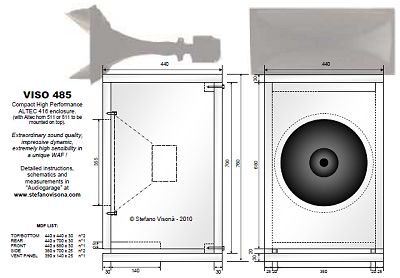| Copyright Steveviso |
VISO 4-8-5 |
|||
|
"Nothing sounds better than a horn, nothing sounds worse than a horn" - Ciro Marzio - CHF Absolutely true. A badly constructed or designed horn cracks, whistles and trills the ears. But a good designed horn system is incredible. It is difficult to explain, but the sound has nothing to do with that classical Hi-Fi sound described by audio reviewer ("air around the instruments" or "velvet and sweet high frequency). I read somewhere that the main difference consists in the fact that with "a traditional" system who play music is there, in front of you, while with a horn system who play is with you, around you. I can say that I find it true, now that I am writing these lines with my VISO 4-8-5 playing from some days. But not only. Dynamics, the speed is incredible and I can forget the small problems in frequency response that I have not still resolved (while I write the system still has the first one crossover). Music exits fluid, charming, you can listen for hours without getting tired. Sure, all this I did not know before. The first idea was to try "a true" horn system, after some not very good experiments I did with single driver and back loaded horn (that are not true horn I can say, infact after some months I sold drivers and go back to my old Sonus Faber speakers). I wanted high efficiency speaker. Dynamics, detail, speed. I was tired with high quality speaker but "hard" (of low efficiency I mean), speakers eating all the microdetail. I did understand it while working on my amplifier, VISO 3-00, when changing the working points of the 300B I did not feel the differences that I expected. So I wanted a front, high quality horn system. Horn systems anyway are big. They have a WAF (Wife Acceptance Factor) rather low. And my listening room is not so big. So I decided to design a "compact" enclosure, that could integrate in the room and furnishing. Not too compact, anyway, because I want a good, clear and fast bass extension (I listen rock music mainly). And without the bum-bum from "tamarro" subwoofer of course. |
||||
I Altec Components
Why just the Altec? They are "vintage" components, not anymore in production. Uh, for those that don't know this speaker I could say that they are considered exceptional, some of the best drivers never produced. Originally born for professional use (when there was not availability of large powers and they had however to guarantee high sound pressures) they have low mass, very high sensibility in spite of generous dimensions (woofer 416 I mean) and a frequency response incredibly extended. And then they play ... wonderful, I can confirm it now. But if I must be sincere I should admit that in the choice has influenced also the idea to carry in my house "a piece of audio history". The Altec Lansing that produced them does not exist anymore and these loudspeakers are outside production from a lot. Today it is possible to find used speaker on ebay or from specialized retailers. It is not easy from Europe (sellers are usually from USA), because you should decide to buy only on the basis of some photos and some answers the sellers gives you... (i.e. the Re of the coils, the cone numbers, the serial numbers... ). However, at the end, when they arrive at your home in their double package, and opening them you feel the weight, the consistency and you get lost observing their cones, you understand that the pain is been worth some. |
||||
Enclosure design. So, my goal was a compact enclosure (with an acceptable WAF, but not only for my wife, also for me), max width 450mm (otherwise I would not be able to insert them in the space between furniture in my room). So the 511 horn should be mounted outside, on the top (at Japanese way). This is an advantage anyway, because it is easier to allign acoustic phase between woofer and tweeter. I spent weeks and weeks with WinISD (before buying the 416), simulating hundreds of enclosures and vents. I repeat simulations in Speaker Workshop (after have them receipts and measured the T/S parameters) and the proud result is shown below (plans available JPG o PDF). The final dimensions have turned out in 760mm of height x 440 of width x 440 of depth, for an inner volume around the 100 liters. With a complete filling of insulating material, woofers can "see" an appearing volume of 130 Liters. Another important point of the design is the vent of rectangular shape, (20 x 350 mm and total length 170mm), placed on the front lower part of the box. For its position and shape, it is very easy to modify dimensions of the vent, inserting wood pieces 20x20mm. So, modifying internal insulating filling and/or dimensions of the vent it is possible later to modify the low response of Altec 416! It is a very important and unique possibility of fine-tuning in my opinion, so you can adjust the bass to your taste or to better fit to the sound characteristics of the room. I have simulated several possible answers in low range with various factors of filling and various dimensions of the vent. In practical, with this system it is possible to modify the response between the two ends that you see under. In attached file XLS you can found also a series of intermediate responses. Moreover, for as it has been built (like you will see after), vent could also be shortened or be lengthened in a very easy way. |
||||
 Vent max dimensions (350 x 20 mm), filling max. |
Vent reduced (170 x 20 mm), without insulation filling. |
|||
| Continues with a detailed Enclosure construction | ||||




